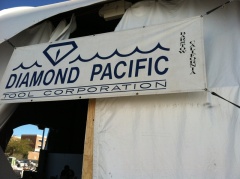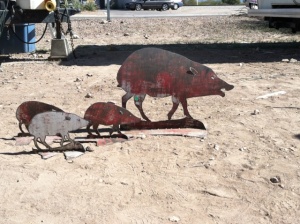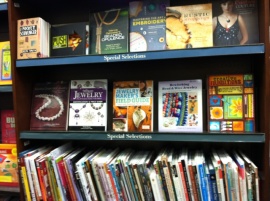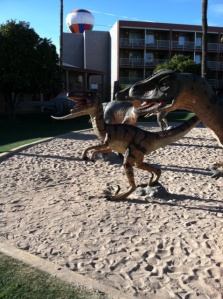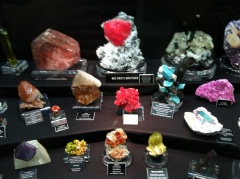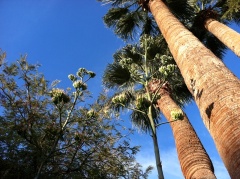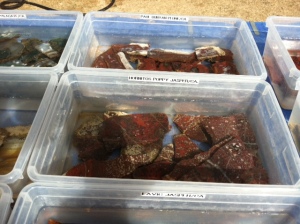I have been preparing like mad for several spring teaching engagements, and I have finally gotten my head above the water. With just two weekend days and evenings per week to get ready, it’s been a race to the finish – because my first classes are almost upon me. The last thing I have left is to prep my comprehensive shopping list to take to the Tucson Gem and Mineral Shows. I’ve got half-packed kits all over the studio, instruction sheets to print, and little boxes and bags of demo pieces all over the place. I love teaching, but it is inevitable that when my mind is sharply focused on what I am soon to teach, something comes up for a student from a class I already taught. Then, I end up juggling questions from students about last year curriculum and questions from organizers about soon-to-come curriculum simultaneously. My brain hurts.
One of those questions came up last week about my “One Hour Rings” video:
“Hello Helen. My name is David. I watched your video (One Hour Rings) and I was left with a few questions. For starters, where can I buy a sanding disk? I can’t find one anywhere. Secondly, you said to quench the metal in water after soldering, can I do that with white gold? Somebody told me that I can’t. I would appreciate it if you could get back to me. Thanks again for such an informative video!!”
And shortly after he replied to say it was OK to answer his question here, David sent me a second email, with a link to a website, picturing a titanium ring:
“Hello. It’s me again. I just had one last question. I have been wanting to make myself a ring for a while now. I finally found one I want to make, but I wouldn’t know how to set the stones like that. It can be viewed here. It is the picture on the left. I was wondering if you had a video or could explain how I could make a ring like that and set the stones like that. I would really appreciate it. Thanks!”
Really, I don’t suggest copying someone elses work, but in this case, the ring pictured was a plain, half-round band with a flush set stone. The only real challenge to fabricating the ring in question was the metal: titanium. But, back to the original question first:
1. Sanding discs (search for brass-center snap-on sanding discs) – my preferred brand is Moore’s. I get mine from either Kent’s tools in Tucson: www.kentstools.com or from Rio Grande: www.riogrande.com. Don’t forget a mandrel for them — they require a square center mandrel for easy switch outs, which is why I love them.
2. Quenching Gold – don’t do it. Especially white gold, because it will cause extreme brittleness in the metal. For hard-wearing jewelry like rings, weak metal is not a good idea. Weak metal is never a good idea, actually. Just let your gold air cool on a steel block. Then, pickle it before proceeding.
3. The ring in question – features plain, ordinary half-round stock and a flush set stone, sometimes called a “Gypsy setting.” I’ve never fabricated Titanium, so I can’t help you on that, but any really good reference on stone setting will give you step by step instructions on how to create a flush setting. However, I am a firm believer in “Show, don’t tell,” so, here is the proverbial picture is worth a thousand words shot…
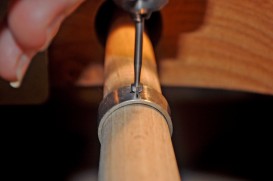
You’ll notice that a setting bur has virtually the same profile as a standard, round faceted brilliant cut stone. Never bur deeper than the top of the bur.
And here’s an ultra-simplified bullet point process on how to do this:
• Fabricate a band thicker in gauge than the deepest part of the stone – measuring from table to culet.
• Use a drill to start a hole in the band, then switch to a setting bur the same size or slightly smaller in diameter than the stones girdle.
• Cut the seat to the depth that causes the girdle to be just below the surface of the metal.
• Set the stone in the seat, then bouge the metal in and up to the girdle of the stone to set it securely in place.
Fair warning: it’s a lot tougher than it sounds here. It takes a lifetime of practice to set stones professionally, but there is no reason not to try. I’d suggest practice with CZs on brass, and really reading up on stone setting. Again, it’s fun, but it isn’t easy. There are loads of books on the topic out there, as well as Ann Cahoon’s brand-new and fabulous video called Introduction to Gemstone Setting available from IWP. I was at the filming for that video and for her next one, and Ann is a real pro!
And, to my 2013 “Rotary Tools Demystified” students — I finally got your resource list ready.
Email me if I missed you, or if you still need one…
